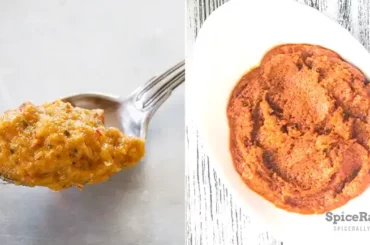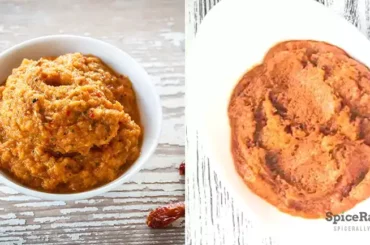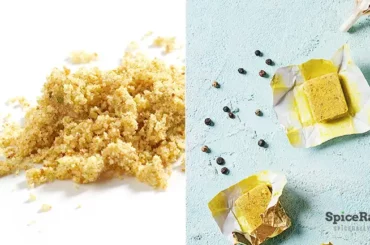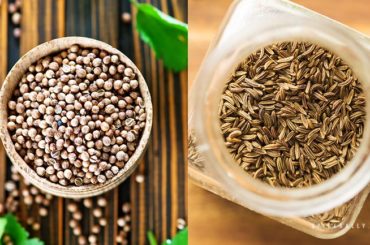Massaman curry paste is the key ingredient to any tasty Thai Massaman curry. So, here are some of the best Thai Massaman curry paste substitutes that will assist you when the original blend is not around.
Some homemade and shop-bought alternatives will help you in place of the original Thai Massaman curry paste. And they include the following:
- Homemade Thai Massaman curry paste
- Panang curry paste
- Thai red curry paste
- Thai green curry paste
- Thai yellow curry paste
- Vindaloo curry paste
- Curry laksa curry paste
Read along to know how exactly these substitutes are applicable instead of our topic leader and how effective they can be.
The Best 07 Thai Massaman Curry Paste Substitutes
Thai curry pastes are generally ubiquitous, but still, there can be situations where you need to count on an alternative– you might run out of the original product, couldn’t find it around, or you may also not like the exact taste.

In such instances, we have shared seven possible Thai Massaman curry substitutes that will bring a similar effect. There’s actually nothing quite like the Massaman curry paste. Yet you can hold on to a few options which can be effectively used to get a comparable spicy, flavorful, and vibrant flavor profile.
01- Homemade Thai Massaman Curry Paste
When you run short of your shop-bought Thai Massaman curry paste, could find it from your local supermarket, or even have had enough of the taste of store-bought options, making your own is the best bet.
Making this curry paste at home is not rocket science, as it calls for some basic pantry staples along with a few special ingredients. You can make a fresh batch of authentic Thai Massaman curry paste in under 30 minutes, followed by proper techniques.
Pros of using homemade Thai Massaman curry paste:
- It works the same as any store-bought Thai Massaman curry paste variety.
- You have control over every ingredient you add.
- You can make it veg or non-veg, depending on your preference.
- Homemade versions are better-tasting, preservative-free, and come out more fresh and aromatic.
Cons of using homemade Thai Massaman curry paste:
- Due to preservatives included in some store-bought options, they can be kept outside at room temperature even after opened. But you will have to refrigerate homemade Thai Massaman curry paste since no preservatives are added.
- Sometimes you may find it hard to get some ingredients required for this curry paste, such as fresh galangal in local stores if you live outside Thailand.
02- Panang Curry Paste
If you can’t find the Massaman curry paste around or wish to savor something different, you can undoubtedly go for panang curry paste as the next best alternative.
The base ingredients, such as galangal, lemongrass, garlic, red chiles, etc., are similar to both the curry pastes, making it a better replacement. The inclusion of peanuts in Panang curry paste is a significant difference, and we don’t get this ingredient in our topic leader.
Panang curry paste can be bought from the shop, just like Thai Massaman curry paste, or even be made at home. However, you should expect a less spicy, nutty, and sweeter undertone if using this option as a substitute. Therefore, you can use this substitute in a 1:1 ratio or adjust the amount depending on your palate.
Pros of using Panang curry paste
- You can get a similar texture and color
- The flavor will be very similar due to the same base ingredients used
- Applicable in any dish that originally calls for Thai Massaman curry [paste as a secondary ingredient.
Cons of using Panang curry paste:
- Not suitable for those with nut allergies
- A considerable nutty flavor can be expected; therefore, it might change the expected taste of your dish.
03- Thai Red Curry Paste
Universal red curry paste is the most common curry in Thai cuisine. Thanks to the base ingredients used in this option, this too can be used as an effective substitute for Thai Massaman curry paste. Thai red curry paste is more widely available than our topic leader and can even be made on your own using fewer ingredients than in the Massaman curry paste.
Both share fundamental ingredients like red chiles, galangal, coriander root, lemongrass, coriander seeds, cumin, etc., while Massaman curry paste contains more spices. Thus, the red curry paste is less spicy than our topic leader.
The red curry paste is also more reddish in color, with more red chiles, making it hotter than the Massaman curry paste. Accordingly, you can go for a 1:1 substitution or use a little more or less, adjusting the flavor as you build up the flavor.
Pros of using Thai red curry paste:
- The same texture and similar flavor can be obtained
- Applicable in most instances where Thai Massaman curry paste is originally required.
- Widely available even out of Thailand
Cons of Thai red curry paste:
- It can be less robust and spicy due to the lack of many spices
- It might not be suitable for those who expect less hotness since more red chiles are included in it.
04- Thai Green Curry Paste
Thai green curry paste is another main ingredient used in Thai cooking as much as Thai red curry paste. This option is considered a possible alternative because it shares the same set of key ingredients such as chiles, pepper, galangal, garlic, shallots, coriander roots, lemongrass, etc.
But Thai green curry paste possesses a more herbal overtone due to the addition of fresh herbs such as Thai basil and cilantro. Moreover, it also contains fresh Thai green chiles instead of red chiles, making it more fresh-tasting than the Thai Massaman curry paste.
In regard to these reasons, this alternative can be a bit hotter than our topic leader, while it also lacks the intensity of the original blend. Nevertheless, you can start with a small amount and then alter the quantity depending on your preference.
Pros of using Thai green curry paste:
- It can expect a similar texture.
- Incorporates well with coconut milk-based dishes similar to the Massaman curry paste.
- It gives a more healthy, refreshing flavor.
- It can be easily made at home or widely available in stores outside Thailand.
- It can be used in most recipes in place of our topic leader, where you can expect a similar flavor than the color.
Cons of Thai green curry paste:
- Color is different compared to the Massaman curry paste.
- It contains more green chiles; therefore, it can be too intense for those who are sensitive to heaty food.
- Lacks the robustness of dry, toasted spices.
05- Thai Yellow Curry Paste
Belonging to the same Thai curry paste family, the yellow curry paste boasts a profundity of flavor just as much as our topic leader. This option also contains the same base ingredients that are common to all Thai curry pastes, such as galangal, lemongrass, chilies, pepper, etc.
Thai yellow curry paste stands out from the rest as it also includes additional ingredients such as curry powder and turmeric, especially which we don’t usually see in the Massaman curry paste. But still, this makes a great alternative.
This is good to go in the same amount you use the Massaman curry paste. But if you are uncertain about substitutions., you can start with a small amount at the beginning and then proceed as you build up the flavor and texture.
Pros of using Thai yellow curry paste:
- It can get a similar consistency, especially when combined with coconut milk.
- Lends a spicier undertone thanks to the inclusion of curry powder
- It can be used in most dishes that initially called for the Massaman curry powder as a secondary ingredient.
- Requires a fewer amount of ingredients to be made at home and otherwise readily available in the store even outside of Thailand
Cons of using Thai yellow curry powder:
- Includes a generous amount of Thai chiles so that this option can be hotter than Massaman curry paste
- A color difference can be expected due to the vibrant yellow color of this substitute.
06- Vindaloo Curry Paste
Hailing from the traditional Goan cuisine, vindaloo curry paste combines many spices with an incredible flavor. Its flavor profile is very similar to that of our topic leader. This alternative shares many fresh and dry spices used in the Massaman curry paste, such as:
- Cumin seeds
- Coriander seeds
- Cinnamon
- Cardamom
- Cloves
- Peppercorns
- Red chiles
- Garlic
- Ginger (takes the taste of galangal)
However, this option might not contain other unique ingredients like shrimp paste, coriander root, or lemongrass. But still, this can be used in most instances to mimic the flavor of the Massaman curry paste when used in a 1:1 ratio, less or more, depending on your preference.
Pros of using Vindaloo curry paste:
- A similarity in texture can be expected.
- It adds depth and the flavor of spices just as much as our topic leader does.
- It can be easily made at home or bought from leading supermarkets.
- Is applicable in many dishes that initially required the Thai Massaman curry paste as a secondary ingredient.
Cons of using Vindaloo curry paste:
- Lacks the unique taste qualities of Massaman curry paste
- It can be too hot for some palates due to the addition of many red chiles
- It might not be suitable for every application that calls for an authentic Thai flavor.
07- Curry Laksa Curry Paste
The last option in our list is something you can use to have a very similar flavor to Thai Massaman curry paste. Curry laksa curry paste is the key ingredient for making curry laksa. This curry paste usually comes together with similar elements, such as
- Red chiles
- Galangal
- Garlic
- Coriander seeds
- Coriander roots
- Cumin seeds
- Kaffir lime zest
- Shrimp paste
- Shallots
This might also contain additional ingredients like palm sugar, dried shrimp, turmeric, etc. You can start with a small quantity of curry laksa curry paste and adjust the amount depending on how flavorful you need your dish to be.
Pros of using curry laksa curry paste:
- The texture and color are similar to that of our topic leader
- This substitute has the perfect balance of flavors, so you can expect a more flavorful dish.
- Curry laksa curry paste is readily available in stores, and you can also make it effortlessly at home using a few simple ingredients.
Cons of using curry laksa curry paste:
- It can only be used in a limited number of dishes that originally called for the Massaman curry paste.
- It might contain dried shrimp other than shrimp paste, which can be unfavorable for vegans and vegetarians.
Use These Thai Massaman Curry Paste Substitutes To Enjoy Your Favorite Thai Dishes Anytime!
Thai Massaman curry paste is a staple in Thai cuisine and is known for its unique robustness, made with an incredible combination of many dried and fresh ingredients. Since it stands out from many other ordinary curry pastes, you must have thought it would be difficult to find an alternative.
But luckily, there are possibilities, such as Panang curry paste, Red curry paste, Yellow curry paste, Vindaloo curry paste, etc., that will help you obtain a similar effect to that of our topic leader. So that now you can effectively count on these replacements, treat your loved ones with a tempting Thai meal anytime you want!




